Homecoming Weekend Offered Special Moments for Alumni, Parents and Community
More than 1,500 Capital Region residents flocked to the Oct. 18 Open House for the Center for Environmental Sciences and Technology Management, considered already one of the region’s most exciting structures, inside and out.
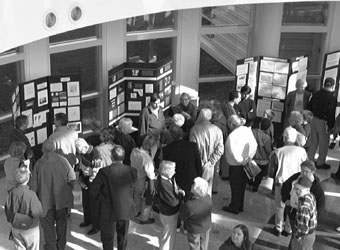 |
One group waits for a tour to begin. |
| A young man checks out a global climatic model used by the National Weather Service and the University’s Atmospheric Sciences Research Center. |  |
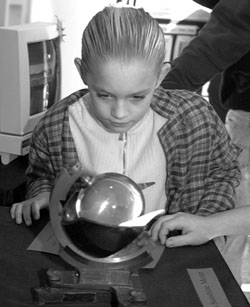 |
A youngster peers into another of the hands-on exhibits at the CESTM event. |
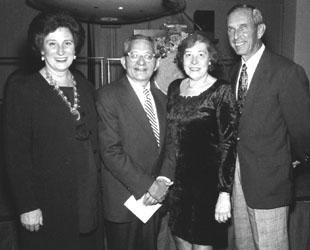
Winners of the 1997 Distinguished Service Medal stand with President Hitchcock at the Presidential Recognition Dinner. At left are Mr. and Mrs. Lawrence Gralla, parents of two graduates, founding members of the successful Parent’s Association and Parent’s Fun volunteers. To their right Richard “Doc” Sauers, head coach of the Great Danes basketball program for 41 years and one of only 11 coaches in college basketball history to reach 700 victories . Not present to receive his award was Timothy O. White, publisher of the Times Union newspaper, who lent support to the University’s efforts to build CESTM and bring the New York Giants summer camp to campus. The medal is conveyed by the University Council to recognize specific acts or actions by a citizen or public official which benefits the course of public higher education in the state and/or materially enhances the standing and capability of the University.
 |
Fireworks mark the spot, as the new University Library is officially topped off on Saturday night, Oct. 18, before a crowd of alumni, parents and students. |
Interdisciplinary Effort
Keeps the Movement to Music Going on Campus
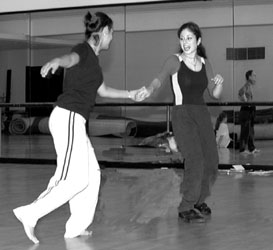
John LeMay
World-renowned dancers as well as accomplished dancers from the Capital Region are visiting the University this semester as guest instructors, enabling students — and members of the public who are interested — not only to see them perform but to study with them in a studio setting.
The dancers are teaching a series of master classes in dance offered by the Department of Theatre in collaboration with the College of Arts and Sciences and the Department of Physical Education. Langdon Brown, chair of the Department of Theatre, said the classes “provide professional level instruction from working artists in dance.”
The series came about through the initiative of dancer/choreographer Jamie Stiller, who has taught dance at the University since 1993, and through the combined efforts of the theater department, the School of Arts and Sciences, and the Vice President’s Office for Student Affairs. During Stiller’s long involvement in professional dance both in New York City and in the Albany area, she has forged a network of contacts that enables her to draw outstanding artists to campus.
Locally — and notably — Stiller choreographed A Christmas Carol at the Palace Theater in the productions that featured the first year Wilfred Brimley and after that John Astin as Scrooge. She also choreographed Junk Bonds at Capital Rep and her work has been showcased at Skidmore College, the Emma Willard School, and the Equity Library Theater in New York.
The classes are held in the University’s dance studio in the Physical Education Building, which Stiller called “one of the most beautiful dance spaces in the world.”
The classes were a rebirth of the old dance and exercise classes, taught part-time in the Department of Physical Education, which was eliminated last June.
Brown points to Gail Cummings-Danson, Associate Director of Athletics, “as the person who admired how Jamie Stiller had rebuilt these courses in the last years of the department. She became the first primemover in getting things going.”
Soon, Director of Athletics Milt Richards, Vice President for Student Affairs James Doellefeld, Dean of the College of Arts and Sciences Cy Knoblauch, and Brown were on board. “A theater department naturally needs movement courses as part of its curriculum for its actors,” said Brown. “And of course the courses were very important to Footworks, the dance club on campus.
“The result is a really excellent example of people working across
disciplines to do something valuable for a good many students and the
campus as a whole.”
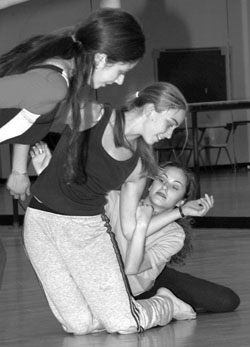
One of this fall’s classes — on technique — was led by a member of Taylor 2, an international touring company founded by Paul Taylor, widely regarded as the premier choreographer in the world. Another class was led by a member of Paula Josa-Jones/Performance Works, a nationally known company whose work the Village Voice has called “powerful” and whose director the Boston Globe has called a “leading choreographic conceptualist.”
Stiller believes strongly in the value of this instruction for students: “One of Paula’s company members came over and did an improvisation with the class based on the performance that the company presented later at Skidmore College,” she said. “When the class went to the performance they saw it on a level they wouldn’t have understood without the class.”
Sue Cherry, dance director at the Emma Willard School, taught a class in the series on contact improvisation, and upcoming sessions will feature Elena Mosley, director and founder of Kuumba Dance and Drum, based in Hudson, New York; and, on Nov. 17, Jane Comfort, an internationally known choreographer whom Jennifer Dunning of the New York Times has called “a postmodern pioneer.”
Mosley, who teaches privately and works with inner city youth through an organization — co-founded with her husband — called Operation Unite New York, will introduce the class to Caribbean and West African rhythms and dance.
Comfort is known for integrating the spoken word with modern dance and for addressing social and political issues in her work — particularly issues of gender and race. A piece entitled S/he, for example, contains a scene in which the Anita Hill/Clarence Thomas scenario is rearranged to feature a white woman who is accused of sexual harassment by a white male, and who is then interrogated before a senate panel made up of African-American women.
Stiller said she feels that Comfort’s work has a lot to offer today’s students and that her work deals with “issues that students are dealing with now.”
Brown, the theatre chair, said the master class series represents “a number of agencies coming together to enhance the cultural life of the campus.” The program is jointly funded by the Department of Theatre; the College of Arts and Sciences; the Office of the Dean of Undergraduate Studies; The Office of Affirmative Action; the Dance Council; and the Performing Arts Center.
The master classes in dance will continue at least through next semester. Spring schedules will be available soon. The classes are open to the University community and to the public at large. No prior experience is necessary. Further information is available from the Theatre department at 442-4200.
Share Our Strength: English Class Helps Plan Reading to Help the Jungry
By Carol Olechowski
Music may be the food of love, but some Albany students are hoping that writing — and an Oct. 30 public reading they have organized — will help them provide food for the hungry.
In conjunction with Share Our Strength, a Washington D.C.-based project working to end hunger around the world, 15 students enrolled in Peggy Woods’ Advanced Poetics (English 304Z) course began early this semester to plan the reading, which is scheduled for 7 p.m. Thursday, Oct. 30, at the Uncommon Grounds coffeehouse, 1225 Western Avenue, Albany.
The program will not feature the undergraduates’ own writing; rather, they have invited area writers whose poetry and fiction they admire to showcase those works. The planners themselves will collect donations, sell raffle tickets, and serve as emcees.
Participants will include nationally recognized poet and University professor of English Judith Johnson; Barbara Chepaitis, an Albany graduate and English department faculty member whose first book, The Fear Principle, is being published; Schenectady poet Michael Scriben; graduate student and fiction writer Yomika Bennett; and Naku Butler, a junior who writes poetry. Two or three other presenters will also read from their works.
The entire program is scheduled to last approximately 90 minutes.
A suggested contribution of $3 each for students and $5 for all others is requested for admission; donations of canned goods will also be accepted. Tickets for the raffle will be available at $1 each. According to Woods, all monetary proceeds will be sent to Share Our Strength, then returned to the Capital Region through the Nutrition Consortium of New York to support that organization’s efforts to end childhood hunger. Canned items will be distributed through the Regional Food Bank in Albany.
Writing Sequence Director Amy Lee praised the students and Woods for “the commitment, energy, time, and labor they have expended in this worthy and important cause” — their contribution to the sequence’s Community Action Learning Projects. Lee added that “the project has presented them with intellectual and strategic challenges a conventional ‘assignment’ could not. They moved beyond the idea stage to make this happen.”
Woods agrees. The students sprang into action, canvassing local businesses to request donations of merchandise and gift certificates for the raffle. Among the businesses that responded were the Book House, the Silver Parrot, and The Toy Maker, all of Stuyvesant Plaza; and Justin’s. The feminist literary magazine 13th Moon contributed a subscription and a T-shirt. And Uncommon Grounds provided both a gift certificate and free use of the space for the reading.
Using a press kit provided by Share Our Strength, the undergraduates wrote a news release and worked to publicize the reading through the local media. They also reached out to the literary community through the New York State Writers Institute and its director, William Kennedy. A scheduling conflict prevented the Pulitzer prize-winning novelist himself from participating in the reading, but he donated an autographed book for the raffle, as did Judith Johnson and Tobias Wolf.
Woods also encouraged her students to contact other authors, including Stephen King, Margaret Atwood, and Anne Rice. “John Irving responded right away. His personal assistant called to say he was flattered by the invitation but unable to come because he had tight deadlines to meet; he has a new book coming out in the spring,” said Woods. She is certain that — owing to writing deadlines, travel schedules, and other personal and business commitments — those who have not replied have probably not yet seen the letters, but will respond. In any case, writing to the literary luminaries was “a good experience for the students — a chance for them to communicate with these writers they admire.”
Aside from its primary purpose of helping others by alleviating hunger, the reading will have other outcomes. The program will provide a forum where one group of writers — the English 304Z class — comes together with the public to acknowledge and appreciate the work of another. A writer, Woods noted, “needs to create that space for other people. A writer pays his or her dues, and provides a showcase for others.”
Woods also hopes to dispel the image of “the isolated writer scribbling away in the garret, oblivious to everything and everyone else. Writers do have a responsibility to the community, and they can use their talent to benefit others.”
Each fall, approximately 2,000 writers nationwide read their works at Writer’s Harvests to raise money for Share Our Strength.
